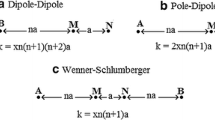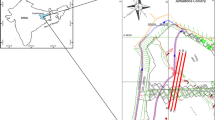Abstract
The present study deals with delineation and mapping of subsurface voids which are very common around the Patherdih colliery of Jharia coal field, India. These are caused by coal fire and old unplanned/illegal mining activity. Initially, a conceptual model of void formation associated with coal fire has been proposed. The burning of coal leads to the void formation due to volume reduction because of transformation of coal to ashes. It is supposed to have significant resistivity contrasts between bedrock i.e. mainly sandstone/clay stone/shale etc. and void space, which are filled with ashes generated from burned coal seam. Field situations have been simulated through forward modeling and the data generated by gradient and dipole–dipole arrays have been corrupted by 5 % noise. The simulations have been carried out for two voids with varied resistivity. The inversions of the data for both the arrays bring up the dimension of the void within reasonable accuracy unlike its resistivity. In fact, the considered resistive void seems to be a conducting void. In the present study, data have been collected by a state-of-the-art FlashRES-Universal electrical resistivity tomography (ERT) instrument, which have 61-channel and 64 electrode data acquisition capacity. ERT sections have been generated over two profiles using Wenner, Schlumberger, gradient, dipole–dipole and joint inversion of all combine arrays. Different resistive anomalous features with resistivity of about 300–200 Ωm have been delineated in both profiles. These are associated with voids at the depths of about 23–25 and 45–54 m generated by burning of coal seams XIVA and XIV, respectively. The obtained results are in broad agreement with the available litholog and surface manifestation of coal fire. The results prove the efficacy of the ERT technique for detection of voids associated with coal fire.














Similar content being viewed by others
References
Abu-Shariah MII (2009) Determination of cave geometry by using a geoelectrical resistivity inverse model. Eng Geol 105:239–244
Bharti AK, Pal SK, Vaish J (2014) Application of self-potential method for coal fire detection over Jharia Coal field. In: 51st annual convention of Indian Geophysical Union, Kurukshetra University, Kurukshetra, 19–21 November 2014, pp 59–62
Bharti AK, Pal SK, Priyam Piyush, Narayan Satya, Pathak VK, Sahoo SD (2015) Detection of illegal mining over Raniganj Coalfield using electrical resistivity tomography. J Eng Geol Spec Pub 65–69
Brown WA, Stafford KW, Shaw-Faulkner M, Grubbs A (2011) A comparative integrated geophysical study of Horseshoe Chimney Cave, Colorado Bend State Park, Texas. Int J Speleol 40(1):9–16
Cardarelli E, Di Filippo G, Tuccinardi E (2006) Electrical resistivity tomography to detect buried cavities in Rome: a case study. Near Surf Geophys 4:387–392
Cardarelli E, Cercato M, Cerreto A, Di Filippo G (2010) Electrical resistivity and seismic refraction tomography to detect buried cavities. Geophys Prospect 58:685–695
Cardarelli E, Cercato M, De Donno G, Di Filippo G (2014) Detection and imaging of piping sinkholes by integrated geophysical methods. Near Surf Geophys 12:439–450
Chandra D (1992) Jharia Coal fields. Geological Society of India, Bangalore, p 149
Dahlin T, Zhou B (2004) A numerical comparison of 2D resistivity imaging with ten electrode arrays. Geophys Prospect 52:379–398
Dahlin T, Zhou B (2006) Multiple-gradient array measurements for multichannel 2D resistivity imaging. Near Surf Geophys 4:113–123
Duba A (1977) Electrical conductivity of coal and coal char. Fuel 56:441–443
Ezersky M (2008) Geoelectric structure of the Ein Gedi sinkhole occurrence site at the Dead Sea shore in Israel. J Appl Geophys 64:56–69. doi:10.1016/j/jappgeo.12.003
FlashRES Universal User manual (2014) ZZ Resistivity Imaging Pty Ltd, Australia, p 36
Gambetta M, Armadillo E, Carmisciano C, Stefanelli P, Cocchi L, Tontini FC (2011) Determining geophysical properties of a near surface cave through integrated microgravity vertical gradient and electrical resistivity tomography measurements. J Cave Karst Stud 73(1):11–15
Guérin R, Baltassat JM, Boucher M, Chalikakis K, Galibert PY, Girard JF, Plagnes V, Valois R (2009) Geophysical characterisation of karstic networks. Application to the Ouysse system (Poumeyssen, France). Comptes Rendus Geosci 341:810–817
Jiang L, Lin H, Ma J, Kong B, Wang Y (2011) Potential of small-baseline SAR interferometry for monitoring land subsidence related to underground coal fires: Wuda (Northern China) case study. Remote Sens Environ 115:257–268
Kumar S, Pal SK, Vaish J, Shalivahan (2015) Utilization of magnetic gradient method for coal fire mapping of Chatabad Area, a Part of Jharia Colafield, India. J Eng Geol Spec Pub 170–176
Lange AL (1999) Geophysical studies at Kartchner Caverns State Park, Arizona. J Cave Karst Stud 61(2):68–72
Leucci G, De Giorgi L (2010) Microgravity and ground penetrating radar geophysical methods to map the shallow karstic cavities network in a coastal area (Marina Di Capilungo, Lecce, Italy). Explor Geophys 41:178–188
Loke MH (1999) Electrical imaging surveys for environmental and engineering studies. A practical guide to 2-D and 3-D surveys, p 63
Martínez-Moreno FJ, Pedrera A, Ruano P, Galindo-Zaldívar J, Martos-Rosillo S, González-Castillo L, Sánchez-Úbeda JP, Marín-Lechado C (2014) Combined microgravity, electrical resistivity tomography and induced polarization to detect deeply buried caves: Algaidilla cave (Southern Spain). Eng Geol 162:67–78
Martínez-Pagán P, Gómez-Ortiz D, Martín-Crespo T, Manteca JI, Rosique M (2013) The electrical resistivity tomography method in the detection of shallow mining cavities. A case study on the Victoria Cave, Cartagena (SE Spain). Eng Geol 156:1–10
Metwaly M, AlFouzan F (2013) Application of 2-D geoelectrical resistivity tomography for subsurface cavity detection in the eastern part of Saudi Arabia. Geosci Front 4:469–476
Mochales T, Casas AM, Pueyo EL, Pueyo O, Román MT, Pocoví A, Soriano MA, Ansón D (2008) Detection of underground cavities by combining gravity, magnetic and ground penetrating radar survey: a case study from the Zaragoza area, NE Spain. Environ Geol 53:1067–1077
Pal SK, Vaish J, Kumar S, Bharti AK (2016) Coalfire mapping of East Basuria Colliery, Jharia coal field using Vertical Derivative Technique of Magnetic data. J Earth Syst Sci 125(1):165–178
Pánek T, Margielewski W, Táborik P, Urban J, Hradecký J, Szura C (2010) Gravitationally induced caves and other discontinuities detected by 2D electrical resistivity tomography: case studies from the Polish Flysch Carpathians. Geomorphology 123:165–180
Revil A, Karaoulis M, Srivastava S, Byrdina S (2013) Thermoelectric self-potential and resistivity data localize the burning front of underground coal fires. Geophysics 78(5):B259–B273
Rodríguez Castillo R, Reyes Gutierrez R (1992) Resistivity identification of shallow mining cavities in Real del Monte, México. Eng Geol 33:141–149
Singh BB, Srivardhan V, Pal SK, Kanagaraju SK, Kumar S, Vaish J (2015) Particle swarm optimization inversion of self potential anomaly for detecting coal fires, a case study - Jharia Coal Field. Third sustainable earth and sciences conference in Celle, Germany, EAGE, 13 October. doi:10.3997/2214-4609.201414282
Song Z, Kuenzer C (2014) Coal fires in China over the last decade: a comprehensive review. Int J Coal Geol 133:72–99
Srivardhan V, Pal SK, Vaish J, Kumar S, Bharti AK, Priyam P (2016) Particle swarm optimization inversion of self-potential data for depth estimation of coal fires over East Basuria colliery, Jharia coalfield, India. Environ Earth Sci (in press)
Stummer P, Maurer H, Green A (2004) Experimental design: electrical resistivity data sets that provide optimum subsurface information. Geophysics 69:120–139
Vaish J, Pal SK (2013) Interpretation of Magnetic Anomaly data over East Basuria region using an Enhanced Local Wavenumber (ELW) Technique. In: 10th Biennial International conference and exposition on petroleum geophysics, Kochi, 23–25 November, p 110
Vaish J, Pal SK (2015a) Subsurface coal fire mapping of East Basuria Colliery, Jharkhand. J Geol Soc India 86(4):438–444
Vaish J, Pal SK (2015b) Geological mapping of Jharia Coalfield, India using GRACE EGM2008 gravity data: a vertical derivative approach. Geocarto Int 30(4):388–401
Vaish J, Pal SK (2016) Subsurface Coal fire mapping of Patherdih Colliery a part of Jharia coal field, India. J Geol Soc India (in press)
Valois R, Bermejo L, Guérin R, Hinguant S, Pigeaud R, Rodet J (2010) Karstic morphologies identified with geophysics around Saulges caves (Mayenne, France). Archaeol Prospect 17:151–160
Van Schoor M (2002) Detecting of sinkholes using 2D electrical resistivity imaging. J Appl Geophys 50:393–399
Verma RK, Bhuin NC (1979) Use of electrical resistivity methods for study of coal seams in parts of the Jharia Coalfields, India. Geoexploration 17:163–176
Verma RK, Bandopadhyay TK, Bhuin NC (1982) Use of Electrical resistivity methods for the study of coal seams in parts of the Raniganj Coalfields (India). Geophys Prospect 30:115–126
Zhe J, Greenhalgh S, Marescot L (2007) Multichannel, full waveform and flexible electrode combination resistivity-imaging system. Geophysics 72(2):57–64. doi:10.1190/1.2435081
Zhou B, Greenhalgh SA (2000) Crosshole resistivity tomography using different electrode configurations. Geophys Prospect 48:887–912
Zhou QY, Matsui H, Shimada J (2004) Characterization of the unsaturated zone around a cavity in fractured rocks using electrical resistivity tomography. J Hydraul Res 42:25–31
Acknowledgments
Authors are thankful to DST for funding a project (SB/S4/ES-640/2012) on geotechnical characterization of Jharia coal field area using Geophysical techniques. Authors wish to thank to the Department of Science of Technology (project no. SR/FST/ESI-104/2010) and University Grant Commission (project no. F.560/1/CAS/2009(SAP-I)) Govt. of India, for using instrumental facilities under these projects. We are also thankful to the Editor and anonymous Referees for their suggestions for improvement of the manuscript. The authors wish to thank to Director, ISM and HOD, Department of Applied Geophysics, ISM, Dhanbad for their support in this study.
Author information
Authors and Affiliations
Corresponding author
Rights and permissions
About this article
Cite this article
Bharti, A.K., Pal, S.K., Priyam, P. et al. Subsurface cavity detection over Patherdih colliery, Jharia Coalfield, India using electrical resistivity tomography. Environ Earth Sci 75, 443 (2016). https://doi.org/10.1007/s12665-015-5025-z
Received:
Accepted:
Published:
DOI: https://doi.org/10.1007/s12665-015-5025-z




